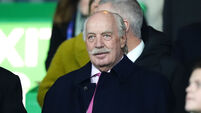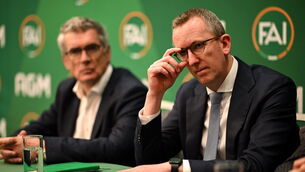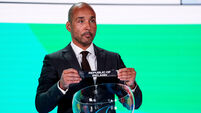John Fallon: January sales carry health warning for Irish

SUCCESS: Rotherham United's Chiedozie Ogbene (right) and Millwall's Murray Wallace. Pic: Danny Lawson/PA Wire.
MID-SEASON moves can cure a mid-career crisis and Matt Doherty will be the latest Irish test case. Many before him have beaten the path to fresh ventures in the January window, a portion against their will, and the success rate has varied.
Proof of that unpredictability is evidenced by the diversity of outcomes among switches we’ve chronicled over the previous decade.
For every winner such as Chiedozie Ogbene, there’s been a howler like Aiden McGeady, reflective of the mixed bag endured by the Irish. We can only wish Doherty well on his Spanish expedition.
Although Robbie Keane’s loan to West Ham United from LA Galaxy was pertinent in the context of Ireland’s upcoming return to the Euro finals stage, the most intriguing transfer was Darron Gibson joining Everton. All the midfielder has known since leaving Derry at 15, bar a brief loan stint in Belgium, was Alex Ferguson and Manchester United, for whom he’d featured sporadically.
Occasions on the scale of the Champions League final were savoured but not with sufficient regularity to reject an approach by David Moyes.
A bright start, including a winning goal against league leaders Manchester City, was unable to be sustained and he made just 38 league starts over five years.
Another Irish graduate at United, Robbie Brady, also fled Old Trafford on a permanent deal but it was his fellow Irish newcomer to Hull City, David Meyler, who laid down roots at the KC over a four-year period.
The Corkman was reunited with the man who handed him his Premier League debut at Sunderland, Steve Bruce, and together they clinched promotion and kept the Tigers there for two years. Meyler also started the 2014 FA Cup final against Arsenal and stayed onboard till 2018, more than repaying the £1.5m fee.
Aiden McGeady was also considered an unfulfilled talent but his return from Russia to join Everton on a four-and-a-half year deal at 25 was deemed an ideal window to thrive. It didn’t transpire in that fashion for as welcome it was to hear how he enjoyed being let off the leash by Roberto Martinez, inconsistency continued to plague the winger and he undertook loans at Preston North End and Sheffield Wednesday before finishing his Goodison career in July 2017 with a mere 43 outings.
In what was a relatively low-key window for the Irish, Ryan Manning’s transfer to Queen’s Park Rangers unfolded as a fruitful one. He was just 18 and a League of Ireland First Division player from hometown club Galway United when Harry Redknapp swooped to clinch a two-and-half-year deal.
He’d have to wait almost two years for a Championship debut under Ian Holloway but the player who converted from attack to wing-back has carved out a career for himself at that level and won six Ireland caps.
Sticking on the League of Ireland export theme, Richie Towell was the standout asset in the Dundalk team that had just retained the league.
He’d also pounced in the FAI Cup final to score the goal which clinched the double, raising his profile and queue of suitors.
Chris Hughton’s Brighton furnished the offer that suited best but he was an infrequent presence, his sole outing that season coming in the playoff defeat at Sheffield United.
A couple of loans at Rotherham United and full-time move to Salford City preceded a return to the domestic front with Shamrock Rovers in 2020.
Robbie Brady’s exploits for Ireland at Euro 2016 meant Norwich City in the Championship was always a temporary existence till Burnley paid a club record €15m to reunite him with Jeff Hendrick. Glimpses of his brilliance were apparent until an accidental clash with former Hull team-mate Harry Maguire ruptured his knee tendons and the comebacks were often smattering.
Brentford spotted a bargain when they came to watch Chiedozie Ogbene destroy his former club Cork City in the colours of Limerick. His pace and power were a lethal fusion for the English circuit and, while he opted to depart the Bees after 18 months, he rediscovered his mojo at Rotherham United and developed into an Ireland regular.
Only a couple of loan deals — Aaron Connolly’s first from Brighton to Luton and Scott Hogan joining Sheffield United from Aston Villa — represented the men’s activities but a significant development was in the women’s sphere with Megan Connolly signing for Brighton.
The Corkwoman was a star in the making from young and her strides in American for Florida State University prompted the Seagulls into action and she’s still a mainstay.
One to allocate to the blunder column. Belief influenced Darren Randolph to accept a West Ham United return from the comfort of No 1 status at Middlesbrough, yet his battle for gametime was bound to affect his assured status between the posts for Ireland. Not the wisest of manoeuvres, just recently ended by swapping for the Bournemouth bench.
Approaching his 30th birthday and his future uncertain at Aston Villa, Conor Hourihane sealed a switch to Swansea City for the second half of the season. It worked a treat as the midfielder was an integral cog of their march to the Championship final at Wembley Stadium, missing out to Brentford on a Premier League spot.
A transaction involving Bohemians and Brighton for a 16-year-old Evan Ferguson warrants inclusion in the winners’ enclosure.
Of the Ireland squad that had finished 2021 strongly, Scotland-based Jamie McGrath was the player seemingly destined to elevate on the club scene. And yet his decision to take leave for Wigan Athletic backfired spectacularly. Perhaps it was the challenge of breaking into a team storming towards the League One table that inhibited him but the nightmare was curbed by trekking back north to Dundee United and the haven of minutes in August.
There was no way back for John Delaney and his board from that shambolic performance inside Leinster House April 10, 2019 but there was sympathy for O’Connell, having stepped into the director of finance berth just two months earlier.
As the gathering took on expected twists, with the treasurer unaware of how many bank accounts existed, attention turned to the newcomer for answers.
They were in short supply during that double-session but O’Connell was widely praised for stepping into the vacuum and trying his best in the eye of the public glare and scrutiny. He’s maintained that manner at the various appearances since, primarily a glut of emergency meetings where the affairs of his department were front and centre.
Ever so gradually his tidings to worried football folk have improved and he was the figureheads clubs and leagues trained on when it came to honouring legacy promises.
And so after that crash course in financial firefighting, there isn’t a person inside or outside of Abbotstown denying him his farewell.
He’s off to work with Paddy Power but the hashtag attached to his farewell bash last week — #allisnotwhatitsems — was taken in the jest it was meant. One is entitled to a laugh after the turbulence he emerged from.
Much of the hype around the League of Ireland has stemmed from increased attendances and the 2023 season will tell whether a viable streaming service can operate in unison.
The season pass which the FAI scrapped last year due to concerns over piracy is returning at a cost of €120, though subscribing per game is still available at €7 for Premier Division and €5 for First Division fixtures. Fanciful notions among certain FAI powerbrokers of streaming becoming a gamechanger internationally were quashed when the pandemic instigated it earlier than planned but that derisory figure of 11,000 purchasers has mushroomed.
According to the association’s stats, the number of users rocketed to 66,000 during their pay-per-game experiment of 2022. Actual users stood at 184,000 but that tally includes non-registered users who logged on for the select games shown free.
Overall 476 games will be available on the LOITV platform — the exception being the matches televised live on RTÉ (men’s) and TG4 (women’s).
Plans for expanding the two-camera set-up operating in the Premier Division into the First Division will depend on the uptake of the season pass by consumers.
Clubs earned a dividend from the profits for the 2022 edition but scale will be required for a standard-setting production to be prevalent across the three entities of Premier, First, and Women’s tiers.








